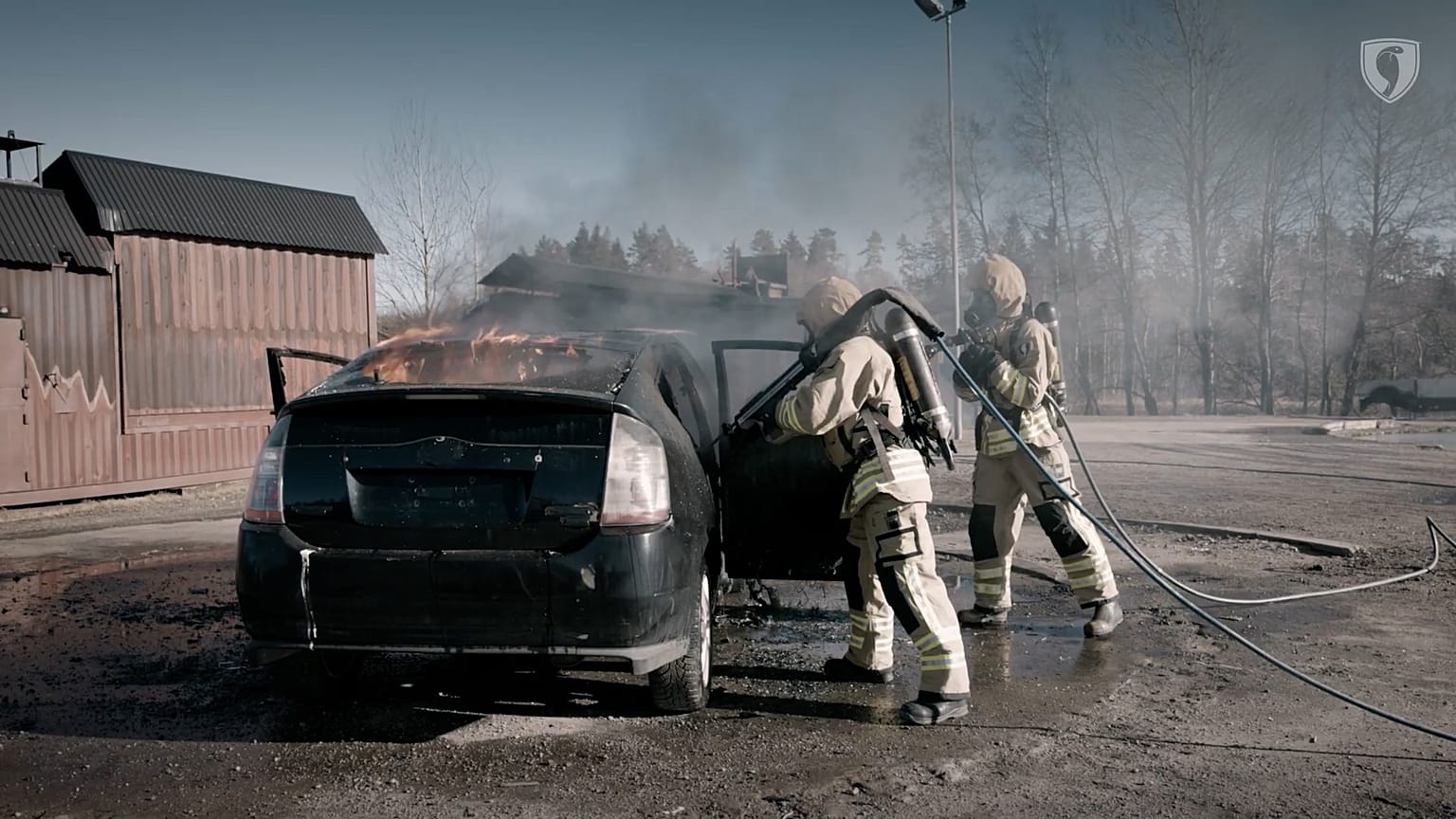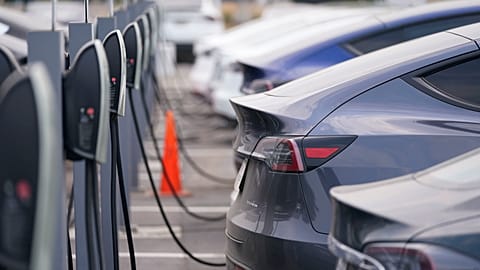While EV fires happen less frequently than in traditional internal combustion engine (ICE) cars, they pose very different challenges for first responders.
Electric vehicles (EVs) have emerged as a promising solution to replace traditional fossil fuel-powered cars.
Yet, amid this transition, one question remains largely unanswered: are we prepared to tackle the fire risks of battery vehicles?
London Fire Brigade this summer named e-bikes as the city’s fastest-growing fire trend with 123 fires associated with e-bikes and e-scooters, a record-high number.
A coroner has urged the UK Office for Product Standards and Safety (OPSS) to introduce further safety standards following the death of a man in an e-bike fire in March, according to the fire and rescue service.
What’s the problem?
Unlike traditional internal combustion engine (ICE) cars, EVs and hybrid cars are powered by lithium-ion batteries which, according to experts, pose different challenges and risks.
One of the known hazards in these kinds of batteries is "thermal runaway," a rapid increase in temperature that leads to fires that are hard to extinguish.
Fire in EVs can start a while after a crash, for example, and can spontaneously re-ignite.
They also produce a toxic gas called hydrogen fluoride when burning. Exposure to hydrogen fluoride can be an additional risk even with protective clothing, experts say.
Snuffing out fires caused by lithium batteries can take thousands of gallons of water, much more than the volume required to stop a gasoline car fire.
According to the International Association of Fire and Rescue Services, extinguishing a burning tesla can take as much as 40,000 gallons of water.
New strategies and technology
Mitigating such accidents requires a combination of preventive measures and improved emergency response strategies.
In 2011, the Swedish Civil Contingencies Agency (MSB) established a team dedicated to publishing reports and guidelines on EV fires.
"We started the project because we could see that electric vehicles were becoming more and more common in society. And we started to discuss them," Yvonne Näsman, an Executive Officer, Fire & Rescue at the Swedish Civil Contingencies Agency (MSB), told Euronews Next.
"We had a workshop and everyone had questions about whether are there other challenges from a rescue service perspective with electric vehicles than diesel and gasoline-powered".
In Sweden, the number of registered EVs has increased by 370 per cent between January 2021 and January 2022.
"A new technology often involves new unknown risks, which means that learning from past events. Lesson learning is extremely important for us, especially when things are quite new," Näsman added.
The team says EV fires happen less frequently than traditional cars. However, knowing the different nature of them, and taking different measures accordingly, is important for first responders.
"The batteries generally burn more slowly than fires in fossil fuel vehicles because the fire in the traction battery propagates from cell to cell compared with a gasoline attack that breaks by fire and several litres of the flammable liquids leak out, resulting in a violent and fast fire," Andreas Forsberg, an Executive Officer, Fire & Rescue at the Swedish Civil Contingencies Agency (MSB), explained.
"But on the other hand, because the fire propagates from cell to cell, electric cars can burn for a period of time instead".
Enhancing preparedness
MSB published a demonstration report this year detailing extinguishing methods of lithium-ion batteries in EVs.
One of the tested methods uses a cutting extinguisher developed by a Swedish firm, Coldcut Systems.
Its Cobra method uses a mixture of sand and water to drill a small hole into the battery casing through a lance and inject ultra-high-pressure water into the module component at 300 bar.
Areas of high temperature known as "hot spots" are constantly examined using a thermal imaging camera, which also determines a safe distance from where operators can intervene.
"We've had an experience of being able to cool the module pack within 15 minutes using less than a thousand litres of water," Martin Orman, the CEO of Coldcut Systems, told Euronews Next.
"So, if you compare that to the typical time, it would take the traditional techniques, you could be using 20 times that amount of water just to cool from the outside. So having direct access to the modules is by far the most effective way of getting an effective result".
Innovation in fire suppression technology holds the potential to significantly enhance preparedness for EV fires. Other novel methods are explored by researchers and engineers in Europe.
In Denmark, emergency services in Copenhagen invented a "fire extinguishing container" in 2020 which was specifically designed for electric and hybrid cars to prevent thermal runaway.
A damaged EV can be placed into it, which can be loaded onto a truck to be driven somewhere safe. The container has nozzles inside to smother flames and cool the batteries of the damaged car.
It can be mounted on a tow truck to be driven somewhere safe.
A rescue service in Leuven, Belgium, has in 2021 also used a water-filled container by using a crane to put the burning hybrid vehicle into it to cool down its battery cells.
Increased risks for the maritime industry
According to a report from insurer Allianz Global Corporate & Specialty, 209 ship fires were reported during 2022, the highest number in a decade.
Experts have pointed out that firefighting equipment installed on many ships isn’t designed for EV fires, following a devastating fire accident on a cargo ship off the Dutch coast in July 2023 with nearly 500 EVs on board.
One member of the crew died and several others were injured in the blaze.
The Danish Institute of Fire and Security (DBI) has run a series of experiments and full-scale trials to see if EVs burn differently and what can be done aboard ferries to mitigate the damage over a 15-month-long project that started in 2021.
"One of the results of this project is a recommendation to provide this specialised training to assist them in addressing such a potential situation," Alexander Bjørn Kleiman, Senior Maritime Project Manager at the Danish Institute of Fire and Security Technology, told Euronews Next.
“You need the right tools and design to address new challenges and new risks, and changing regulations can be cumbersome and time-consuming. So technological development far exceeds the speed at which new requirements can come.” he added.
"So, I believe it's really important to emphasise and do more research to better understand to both find solutions, but also to reassure and disprove maybe misconceptions and build up the confidence and experience".
Experts believe close cooperation between the industry, rescue services and authorities as well as a more standardised approach can contribute to more efficient and consistent preparedness.
"From our conversations worldwide, we don't think that there is a consistent message at the moment. The methods recommended on the rescue data sheets by car manufacturers are a little bit vague," said Orman.
"But this is starting to change because the car manufacturers are now acting more proactively with government departments and that allows them to get agreed methods published for fire safety services worldwide".
The European Commission has this year established a task force to develop fire safety guidelines for recharging infrastructure.
"We believe that the EU can play a supporting and coordinating role by offering guidance to Member States on how to ensure the fire safety of these new sustainable solutions," Eugenio Quintieri, the Managing Director of Fire Safe Europe, told Euronews Next.
"It is also essential for EV users to have some kind of harmonisation across the EU to ensure that they can travel freely with their electric vehicles without facing too many different kinds of restrictions".
According to Fire Safe Europe, fire in an enclosed space such as parking garage entails serious risks because, among others, the fire will likely spread to other vehicles due to the close proximity and such fires are hard for fire services to extinguish.
"However, we are lacking data on fires involving electrical vehicles. This is where the European Union can play an important role by harmonizing statistical methodologies for the collection and analysis of data on EV fires," he added.
For more on this story, watch the video in the media player above.



















